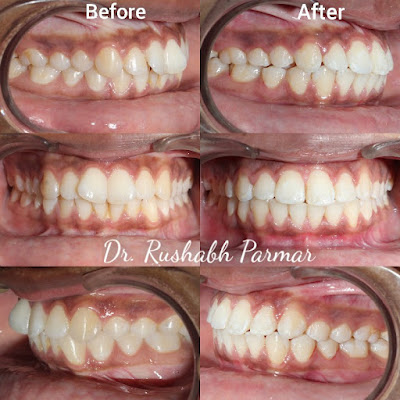Orthodontic Re-Treatment Case
Introduction:
The Orthodontic treatment require the long-term use of a retainer to prevent relapse. So the retainer is very important for any orthodontic treatment. Your teeth are always on the move if you want even if you have had orthodontic treatment in the past. Without retainer, the teeth can gradually shift out of position, worsen the perfect smile that you once enjoyed. Patients who may have forgotten to wear their retainers, have lost their retainers, or who wear their retainers inconsistently may suffer an orthodontic relapse. When this occurs, the teeth may have shifted into positions which can no longer be managed by a retainer alone. In that cases, Orthodontic retreatment is mandatory for the correction of the teeth.
BRINGING BACK YOUR SMILE:
Your teeth may have shifted, your retainer no longer fits, but the smile can again bring back by retreatment and help you to prevent the same problem from occurring in the future. It should be started with a new orthodontic evaluation by assessing the full extent of your relapse through the use of x-rays, photos, study model and a clinical exam. The diagnoses is made with current condition and develop a plan for restoring your smile.
Based upon the severity of the relapse, recommendation of a limited or comprehensive strategy is performed for your retreatment. A mild to moderate relapse can often be corrected with the short-term use of braces on the front teeth or the limited use of invisible braces. A moderate to severe relapse might involve a more comprehensive retreatment approach to include full braces, elastics, rubber bands, or a full set of invisible braces.

Diagnosis:
A 25 years old female patient came with the chief complain of forwardly placed upper front teeth and difficulty in chewing; unesthetic smile. Patient had history of previous orthodontic treatment and upper first premolars are extracted. She had brackets placed in upper and lower arches in current position. The extraoral examination reveals mesoprosopic faceform, mesoocephalic headform, convex profile, competent lips, smile flat, obtuse nasolabial angle. The intraoral examination shows super Class II molar relation, Class II (end on) canine relation with lateral openbite, increase overjet and anterior deepbite and molar rotations. The upper first premolars were extracted in the previous orthodontic treatment. Diagnosis is Angle's Class II malocclusion Division 1 with anterior deepbite and lateral openbite.
Treatment Objectives:
- To achieve Class I canine relation
- To correct proclination of upper anterior teeth
- To achieve ideal overjet and overbite
- To correct lateral openbite
- To improve profile
- To correct nasolabial angle
- To correct smile
Treatment Plan:
- Non-Extraction
- Leveling and alignment (anterior bite plate)
- IPR in upper anterior
- Space closure
- Finishing and detailing in Class II molar and Class I canine relation
Treatment Progress:
The previous brackets were removed from both upper and lower arches. The orthodontic retreatment is started with new bonding in upper and lower arches with standard 0.022 inch MBT preadjusted edgewise appliance. All the first molars were banded and anterior bite plate is given. The initial leveling and alignment process. The sequential change of arch wires were 0.016 nickel‑titanium (NiTi), 0.017 x 0.025 NiTi, 0.019 x 0.025 NiTi, 0.019 x 0.025 SS. After deepbite is correct, anterior bite plate is removed. Interproximal reduction is performed on upper anterior teeth and retraction is carried out. Finishing is done on 0.019 x 0.025 Braided SS wire by settling elastics. After removal of orthodontic appliance, lingual fixed retainer with upper anterior bite plate retainer is given.
Treatment Results:
The posttreatment photographs showed Class I canine relation, Class II molar relation, ideal overjet and overbite, corection of lateral openbite, well coordinated arches. The nasolabial angle is improved. The pleasing smile is obtained with proper interdigitation of occlusion which improve chewing.


.jpg)

Very significant Information for us, I have think the representation of this Information is actually superb one. This is my first visit to your site. Orthodontist Inverness
ReplyDeleteThank you so much
Delete